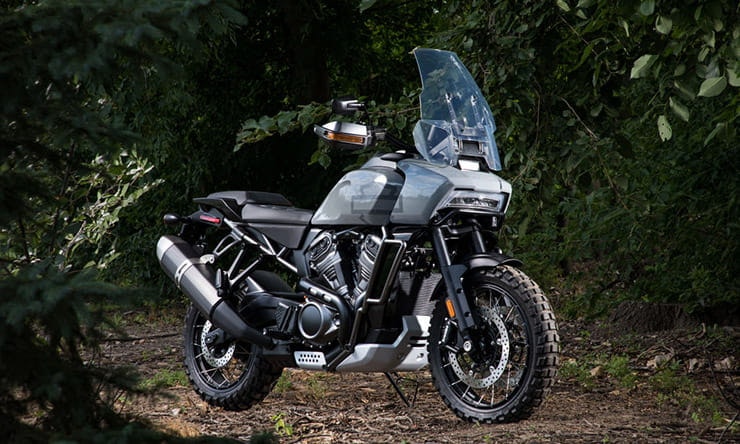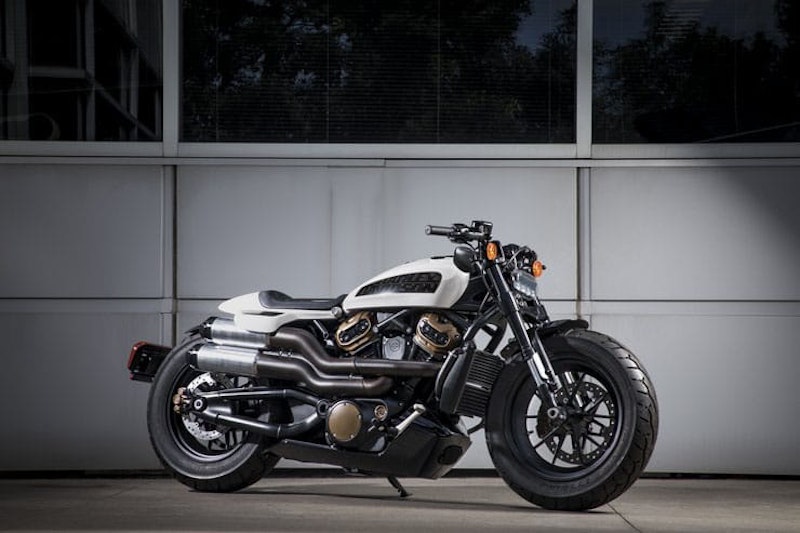Harley to slash range by 30% in cost-cutting shake-up
By Ben Purvis
Motorcycle Journalist
29.07.2020
Pan America adventure bike is now coming in early 2021
Harley-Davidson has announced plans to cut its model range by as much as 30% after seeing a $92 million net loss in the 2nd quarter of 2020.
With bike sales ravaged by COVID-19 lockdowns all over the planet, Harley’s 2nd quarter revenue dropped by 47% compared to the same period in 2019. Globally, its bike sales were down 27%, from 71,800 in the same three months of 2019 to just 52,700 in Q2 of 2020.
Announcing the figures, the firm’s new CEO, Jochen Zeitz, revealed more details of the ‘Rewire’ strategy that he first announced in April. Replacing the previous, ambitious ‘More Roads to Harley-Davidson’ plan that was put into place by his predecessor, Matt Levatich, in 2018, the ‘Rewire’ is now set to become a complete strategic plan – named ‘Hardwire’ – in the 4th quarter of the year.
Water-cooled, 1250cc custom model – shown above – was planned for 2021, but now Harley says it’s focussing on the Pan American next year.
While the full details of the ‘Hardwire’ plan won’t emerge until nearer the end of this year, a core part of the latest earnings announcement is the decision to slash the Harley model range by 30%, while Zeitz also threw doubt over some of the planned new models that the firm has previously announced.
In the short term, the firm has decided to extend its 2020 model year, pushing back the introduction of 2021 models until early next year as it hopes to catch up with sales lost during the lockdown period. The cancellation of big bike shows like EICMA and Intermot also means there’s no pressure to launch next year’s bikes during the autumn in time to show them that those events.
It means that, as we revealed in May, the forthcoming Pan America adventure bike won’t appear until 2021 despite initially being promised for 2020.
Bronx streetfighter, shown last year and due in 2021, is another model that wasn’t mentioned
The 1250cc, water-cooled Pan America is still coming, though, and that might put it a step ahead of other new models as Zeitz pointedly didn’t mention other planned new 2021 machines like the Bronx streetfighter, due to use a 975cc version of the same engine, or the as-yet-unnamed ‘high-performance custom model’ that’s intended to share the Pan America’s 1250cc twin.
In an earnings conference call, Zeitz said: “We see strong potential in Adventure Touring and we launch Pan America globally next year. We will be going to market with an improved launch process, beginning with model year ’21, we will shift our product launch and dealer reveal timing into early Q1, driving demand for products and sales for dealers at the start of the riding season. As we transition this year, we have extended our 2020 model year production through fall and expect model year 2021 bikes will arrive in dealer showrooms early in the new year.”
He also confirmed the plan to ‘streamline’ the model line-up by cutting nearly a third from the range, saying: “We are streamlining our motorcycle models by approximately 30%, with plans to further refine our product portfolio. This enables us to invest in the products and platforms that matter the most, while better balancing our investment in new high potential segments. In this context, we plan to expand our offering of iconic motorcycles, those which most embody the spirit of Harley-Davidson.”
Faired Harley sports bike, above, was part of 2018’s ‘More Roads to Harley-Davidson’ expansion plan but doesn’t seem to fit the new, more conservative approach.
The reversion to bikes that ‘most embody the spirit of Harley-Davidson’ has echoes of the strategy adopted by the firm in the aftermath of the 2008 financial crisis. Then, Harley ditched fringe models, closing the Buell brand and selling MV Agusta – which it owned at the time – for a nominal figure as it retreated to its cruiser comfort zone.
It means that many of the models considered as part of the previous ‘More Roads to Harley-Davidson’ plan, which intended to spread the firm’s appeal to younger buyers, introducing smaller-capacity bikes, more electric models and a selection of high-performance water-cooled V-twins, may never see the light of day. For example, the mooted VR1000-inspired, faired sports bike now seems significantly less likely to happen.
Asked specifically about new models other than the adventure-oriented Pan America, Zeitz said: “At this point, Adventure Touring will be the focus going into next year. As I said earlier, we expect to streamline our product line up by about 30% in terms of model reduction and color reductions. Other product line related decisions, we will be revealing in real time. So it’s not really something we can and want to talk about at this point. But let’s focus on Adventure Touring as an exciting new segment for us going into the new year.”
Asian-made 338cc twin is another future Harley that could be axed
Another significant future Harley is the future parallel twin, 338cc model being jointly developed with Benelli owners Qianjiang. Initially intended to be unveiled around now, in summer 2020, it’s now not clear whether the bike will ever reach production.
It was intended to bolter Harley’s presence in emerging markets, acting as a stepping stone towards larger models, but when Zeitz was asked about the machine he said: “As I said, we would like to reveal our products much closer to actual launch. And whether and when we are going to launch specific products, is not something that I would like to elaborate on right now. We will provide further detail in the fourth quarter. At this point, there’s really nothing new to say about that.”
When questioned about the firm’s priorities, he again emphasised the focus on core customers, saying: “We have extraordinary product and we have more product in the pipeline. But the complexity of our product offering has just been quite substantial, and sometimes it’s even hard to know what product is what and that complexity I think might even be for some customers a bit confusing at times, especially for those who come into the brand, and would like to buy a new bike. That is not a huge problem, but it certainly is something that makes our lives, from a product development and investment point of view, more difficult. And that’s also one of the reasons why we don’t want to just launch into every category at once, but want to be very focused on the ones that are true to Harley, that our customers are looking for and that are not too much of a brand stretch. You can’t be everything for everybody. We are an extraordinary and desirable brand, but that doesn’t mean that we ever want to become everything for everybody. So that desirability needs to be retained and needs to be reflected in the products we offer, and the categories we launch ourselves into, if they are not part of the offering today.”
BMW’s R18 shows how a single model can be adapted to multiple styles – by doing the same Harley could cut its model range without reducing customer choice.
How can Harley cut its model range by 30% while still launching new bikes like the Pan America? The answer is likely to be a rationalisation, reducing the number of variations-on-a-theme that makes the company’s current line-up a constant source of confusion.
At the moment, for instance, there are six models in the Sportster range, differentiated largely by details, and it’s the same story in the cruiser and touring line-ups. Often, Harley adds a new model where a rival firm might simply offer a package of bolt-on extras.
For contrast, look at BMW’s new R18. It’s one model at the moment, but can be ordered with a host of options that can turn it into a bobber, a cruiser or a tourer. You can have different bars, screens, footrests, seats, exhausts, and by combining them turn the R18 into a rival to any one of a dozen individual Harley-Davidson models. No doubt Harley has taken note and realised that it could reduce costs without eliminating customer choice by following a similar route.
Share on social media:

